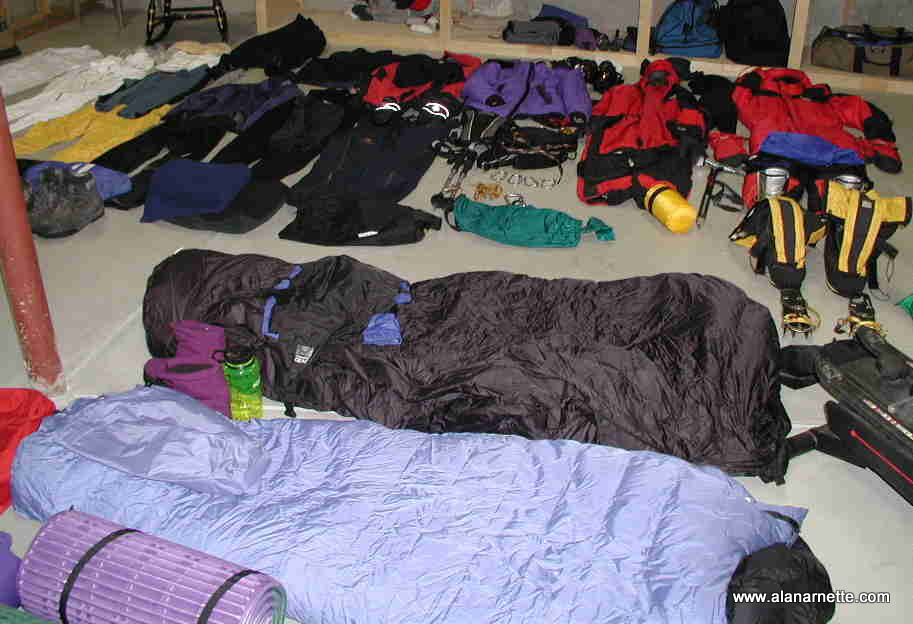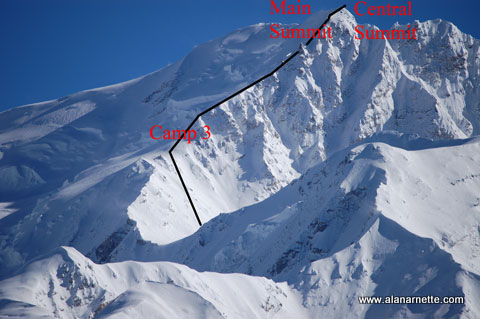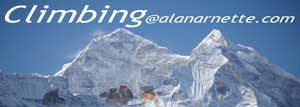Q: Where is Shishapangma?
A: In south central Tibet a few miles from the Nepalese
boarder and about 75 miles east of Mt. Everest. The nearest airports
are Lhasa and Kathmandu. It is the 14th highest mountain on Earth and
the lowest 8000m mountain. It is unique since it is the only 8000m mountain
100% located in Tibet and not on a boarder. Similar to Everest's north
side, there is a road that goes to the base camp sometimes call DC or
Driver's camp. But after that it is all on foot and Yak. View
Larger Map
A: It is a Tibetan name meaning “crest
above the grassy plain". The Chinese call it Xixabangma which is
translated to mean "bad weather" or "severe climate"
Q: What is the history?
A:The first recorded ascent of
Xixabangma was in 1964 by a mammoth size Chinese Expedition consisting
of 195 climbers. Since it is one of the 14, 8000m mountains it been climbed
by famous mountaineers from all over the world including Ed Viesturs,
Reinhold Messner, Doug Scott, Roger Baxter-Jones, Alex MacIntyre, Alan
Hinkes Jerzy Kukuczka and Erhard Loretan.
Q: When is it usually climbed?
A: As with most Himalayan peaks, Spring is best since every
day it gets warmer with less threat of snow. The Fall season is just
the opposite. I climbed in September and had a lot of snowy weather and
severe snow with high winds towards the end that stopped the climb for
our team and all the other expeditions.
Q: I understand that Shishapangma is an easy 8000m climb. How
hard is it?
A: Shisha is often called an "easy" 8000m mountain
in the sense that there is almost no technical climbing (e.g. vertical
walls). However there is always avalanche dangers plus the biggest challenges
is that it actually has two summits. Many climbers who claim they have
summited Shisha have actually only attained the fore-summit (Central
Summit). The true summit (Main Summit) is another 3 meters (12 feet)
higher but requires a traverse of a knife edge ridge or a circuitous
route from the Central Summit Ridge to reach it.
Q: How does Shisha compare with Everest or other 8,000m peaks?
A: It is a great training climb for aspiring Everest climbers
to see how their body reacts to high altitude - 8,000m. It is very similar
to Cho Oyu and Broad Peak except that Broad has more sustained steep
climbing. There are no features like Everest's Lhotse Face or Hillary
Step on Shishapangma but the overall atmosphere is similar.
Q: Is a Shishapangma climb dangerous?
A: Absolutely. You should only attempt Shishapangma if
you have the proper experience and logistics for emergency situations.
It is isolated and helicopter resource is not available. Most deaths
are a result of falls but the weather and altitude also takes it's toll.
Q: How many people have summited and how many people have died
trying?
A: As of 2008 there have been about 273 summits (compared
with approximately 3500 on Everest) according to research.
23 climbers have died, including 1991 when six Japanese climbers were
buried in an avalanche and in 1999, when top mountaineers Alex Lowe and
Dave Bridges died on the mountain. Statistically, Shisha is more dangerous
than Everest in modern times with a fatality rate of 8.4% versus 4.4%
for Everest.
Q: What was your training like?
A: Aerobic capacity, muscular strength, balance and attitude.
I ran, lifted weights, stretched and used visualization techniques
to address these areas. I climbed Colorado 14ers regularly. I had to
reduce my running since my knees just would not take it anymore so
I used an elliptical machine instead. When I did run, I changed from
long 8 mile runs to 3 miles runs with intervals. I climbed to 17,000
on a three week Denali expedition in June 2007 just prior to this climb.
Q: Was altitude a problem on this climb?
A: Yes, it is always a challenge on 8,000m climbs. We
used supplemental oxygen for the summit push. Altitude can be a problem
for anyone above 8,000', much less when you are going above 22,000'.
To acclimatize en route, the travel to base camp takes about ten days
including a trip to Lhasa Tibet.
Q: Can you prepare for the altitude?
A: Not really. The common approach is to move slowly up
the mountain (1000' a day maximum) spending your days at a higher
altitude than where you sleep up until your summit bid. The human
body simply does not function well at high altitudes and especially
above 8000m (26,300'). As you go higher, the barometric pressure
decreases, although the air still contains 21% oxygen, every breath
contains less molecules of oxygen.
Everest legend Tom Hornbein explained it to the American
Lung Association this way:
The lower
oxygen stimulates chemoreceptors that initiate an increase in breathing,
resulting in a lowering of the partial pressure of CO2 and hence
more alkaline blood pH. The kidneys begin to unload bicarbonate
to compensate. Though this adaptation can take many days, up to
80% occurs just in the first 48 to 72 hours. There are many other
physiologic changes going on, among them the stimulus of low oxygen
to release the hormone, erythropoietin to stimulate more red blood
cell production, a physiological and still acceptable form of blood
doping that enhances endurance performance at low altitudes. Adaptive
changes are not always good for one’s health. Some South American
high altitude residents can have what’s called chronic mountain
sickness, resulting from too many red blood cells; their blood
can be up to 84-85% red blood cells. The increased blood viscosity
and sometimes associated pulmonary hypertension can result in right
heart failure.
You cannot do much to acclimatize while at a low altitude but
there are companies that claim to help the acclimatization process
through specially designed tents that simulate the reduced oxygen
levels at higher elevations. I have no personal experience with
these systems but you can find more details at the Hypoxico website.
They cost about $7,000 or can be rented for about $170 a week.
Outside Magazine posted an article in
2013 questioning their effectiveness.
Q: What kind of gear did you use?
A: I have used the same gear for many years now - lot's
of layers and down. It is always critical to protect my toes, fingers
and face since these are most susceptible to frost bite. As for warmth,
I always wear a knit cap and at least liner gloves when I get the least
bit cool - regardless of the outside temp. I use a 3 layer system of
Merino wool base layer (top and bottom), heavier fleece as in the Mountain
Hardware Power Stretch (a Farmer's John kind of suit) or just my Patagonia
Guide Pants depending on how cold it is that day then my top wind or
warmth layer e.g. Patagonia Micro Puff and/or JetStream Shell. When
the winds pick up and the temps hover near 0F, I add my Feather Friends
850 Fill down jacket plus my mitts. See my gear
page for a complete discussion and my gear list updated in 2013.
I am very pleased with all my gear but have a few standouts items.
I note these on my gear page.
Q: Anything new - this time?
A: I switched from a capiline base layer to merino wool.
I have found it to wick faster and stay warmer than capiline. It worked
great.
Q: How do you communicate back home?
I used a satellite phone from Thuraya for
my personal use to transmit both voice and data from anywhere on the
mountain as well as during the trek in. The phone works extremely well
but I experienced some surprises with my subscription since the SIM
expired two days after I arrived. I was unaware that this would happen.
My service provider (Explorersweb's Humanedgetech) tried and failed
to get it resolved but was able to work directly with Thuraya
to get it renewed. I used a Bgan data only satellite station for dispatches
from ABC. It was faster (128KB vs 9600 baud) but more expensive than
the handset ($11 per mb). For details on my expedition communications,
please see this tutorial.
Q: Was there web site coverage?
A: Yes. On this site on the dispatch
page and on the Project Himalaya site.
Other team members posted Blogs and they are listed on Jamie's site.
Q: Which route is most popular?
A: The North ridge from Tibet is the most popular. The
Swiss-Polish route on the South Face is the other common route but this
is extremely dangerous and where Lowe and Bridges were killed by avalanche. Remember
that it actually has two summits: the fore-summit (Central Summit) and
the true summit (Main Summit) which is another 3 meters (12 feet) higher
but requires a traverse of a knife edge ridge or a circuitous route from
the Central Summit Ridge to reach it.
Q: How long will it take?
A: A week or more to get to base camp, 4 weeks on the mountain
and a few days to get back to Kathmandu or Lhasa. Count on 6 to 7 weeks
total.
Q: How much does a standard climb cost with and without a guide?
A: The costs can range from $9,000 to $20,000 depending
on who you use. If you use a logistics company only, you cut the highest
cost by a third perhaps. See my Guide page
for more details.
Q: Do I need a permit to climb?
A: As of 2008, the rules have drastically changed. The
Chinese now require climbing permits to be issued after 5 days upon arrival
in Kathmandu (or Lhasa, I assume). The entire team must be present. Another
permit must be issued by the Chinese military at a post near Tingri.
There may be other new requirements that are revealed so make sure you
climb with an operator with experience with these new rules to prevent
delays and disappointment.
Q: Do I really need a guide for Shishapangma?
A: You will need help getting a permit and entering Tibet
at a minimum. Once there, It all depends on your skills, money and time
available. Shishapangma is a serious high-altitude climb. Some people
go to Shishapangma without a formal guide and contract with local agencies
for yaks, porters or carry everything themselves but this is probably
not an option anymore. There are few climbers on Shishapangma so you
would probably be alone much of the time. In harsh weather (white-outs)
or in a medical emergency, you will be on your own so consider your skill
level carefully. Climbing alone or in too small of a team is never a
good idea.
Q: Are there local guides for Shishapangma?
A: Yes but the Chinese have made significant changes recently
favoring only Tibetan guides, cooks, porters and staff. You will definitely
need some type of assistance. There are many quality choices based out
of Kathmandu that can help with logistics. Some are less expensive than
traditional Western companies but most charge about the same price. My
usual advice is to get recent references from a climber with a similar
background and skill level as yourself. Get everything in writing. Finally
ask about food, group gear and language skills.
Q: How do you get on an expedition to climb Shishapangma?
A: Most reputable guides ask for your climbing resume and require
some serious climbing experience. Ideally they want to see climbs of
Denali or Aconcagua. But most anyone can get on a Shishapangma commercial
expedition these days without many questions so be careful who you select
since you may get caught up in a mess.
Q: What is involved if I plan my own climb?
A: Basically everything: permits, travel, hotels, food,
gear, routes, communications, emergency contentions - everything. There
are local companies in Katmandu who can provide some services such as
getting food or heavy tents to base camp. And some can provide a Sherpa
at low costs. You can save a lot of money this way but as I said before,
consider your skills in the event that something goes wrong - are you
100% self sufficient? What are your medical skills? HAPE and HACE are
really possibilities on Shishapangma - do you have the proper medicine
and training to deal with it? And a hundred more questions. See my guide
page for more. Again, climbing alone or in small teams is never a
good idea. Saving a few thousand dollars is not worth your life.
Q: Did you summit?
A: No. We got to about 7000m before a huge weather
front hit the mountain - the second in a 2 week period. It basically
shut the mountain down. Only 2 climbers reached the central summit in
2007 and none to the true summit.
Q: Which route was used?
A: The north ridge route. This is what is considered the "normal" route.
There were four camps established at roughly 18,300', 21,000', 23,000'
and 24,600'. The summit is 26,335''. An interim camp named the Depot
camp was used on the early climbs to store gear and for one night. It
was at 19,200'. The route follows the Shishapangma glacier to the Eastern
Cwm, up the North Ridge then traverses the North East face to the summit
ridge.
Q: Who ran the expedition?
A: Jamie McGuinness of Project
Himalaya.
Q: What is their history on Shishapangma?
A: Jamie had run three expeditions to Shisha reaching the
Central summit twice. He is based in Kathmandu and uses the same Sherpa
team for many expeditions including Everest and 8000m climbs in Pakistan.
Q: How did Jamie and his team do?
A: The logistics from Kathmandu and Lhasa to and at Advanced
base camp were outstanding with no surprises. The on-mountain leadership
was dependent on each individual since this was not a "guided" climb
with a formal Western Leader or Lead Sherpa (aka Sidar). So there was
some confusion from time to time on who was going where, when. However
there was never a shortage of tents, stoves or fuel at the High Camps.
Jamie ran the expedition enabling each climber to be very independent
and the team in a consensus manner. There was minimal direction as to
the on-mountain activities. The food at BC and ABC was excellent. We
had freeze dried food at the High Camps and cooked it ourselves.
Q: How many climbers were on the expedition?
A: It was too big. We had two teams of 8 people plus Sherpas,
cooks and kitchen help. There were over 25 in camp. But the team dynamics
were the best I have ever experienced and everyone got along well. All
base camps camps were comfortable except for the small 2 person tents
at the High Camps. I would not recommend the Mountain Hardware EV-3 tents
due to their narrow size and poor ventilation. However they are lightweight
and I never had to carry one up so I can appreciate the trade-off.
Q: How was the climbing?
A: The climbing was straightforward. The route to camps 1 and
2 were on snow slopes that varied in angle. There were some steep sections
near the top of both slopes or just below the camps. The route to the
Depot camp followed the glacier and was sometimes on a sharp angle of
loose rock or scree. We had to cross the glacier and a series of 20 to
30 foot ice spires or Penitentes. This was a little of a surprise and
took 1.5 hours the first time. We had a few people slip into the icy
cold waters but no serious damage was done. The climb to Camp 3 on the
Central Summit Ridge was on a steep snow slope that had avalanche danger.
No one even tried it in 2007. From C3 you follow a ridge to the Central
Summit.
Q: What kind of weather conditions did you have?
A: We climbed in late September and early October after
the annual monsoon season has ended. So generally it was clear but
colder than in the spring.We had significant more snow than in previous
years and thus stopped all the summit bids from all teams. The winds
were strong from time to time and thus cold.
Q: Did you use bottled oxygen?
A: No, it is not usually used on Shisha.
Q: Would you climb Shisha again?
A: Yes. I really enjoyed the entire expedition and that
part of the Himalaya and Tibet. If I ever did go back I would aim for
the true summit but be pleased with Central. Also I would return with
Project Himalaya.
Bottom Line
Shishapangma is a fantastic climb especially for your first 8000m
mountain. But there are many complications as of 2008 with the new
Chinese regulations and attitude. The actually climbing is enjoyable
and satisfying. Seeing Tibet is educational and inspirational. But
if the complications continue to grow, the Nepal climb of Manaslu may
be the best alternative for a first 8000m climb. |

